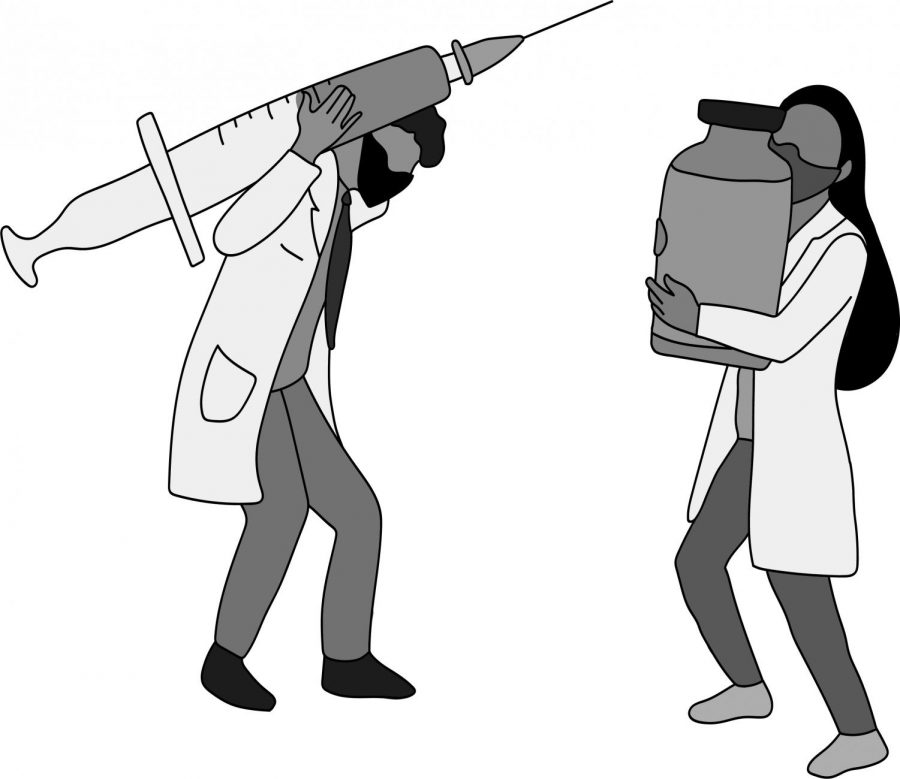Brookings county enters Priority 1c of vaccine distribution
January 13, 2021
After the whirlwind that has been the last 10 months, a vaccine is finally here.
Two pharmaceutical companies, Pfizer and Moderna, sent out vaccine doses across the country this December and some have reached South Dakota; however, South Dakota State University students may have to wait to receive theirs.
According to Jayme Trygstad, campus emergency management specialist, it is not planned for the vaccine to come to SDSU or for students and faculty to receive mass vaccinations any time soon.
“Right now, the vaccine is only being distributed by the health systems per county,” Trygstad said.
Their reasoning is due to the phased approach the CDC and South Dakota Department of Health (SDDOH) have implemented to allow priority individuals access first.
According to Trygstad, Brookings Country just entered Priority 1c of their distribution, which allocates additional public health officials and law enforcement priority. SDSU won’t get theirs until Priority 1d, where “teachers and other school/college staff” will be approved, according to the SDDOH.
According to Vice President of Student Affairs, Michaela Willis, Priority 1d could come as early as February.
“We could start seeing some vaccines for employees starting in maybe February,” Willis said during the Jan. 11 Students’ Association meeting. “I would anticipate that it’s going to take most of the semester even for that level of vaccine to get distributed.”
SDSU is indeed a part of the conversation regarding when and how a Point of Dispensary (POD) will be set up on campus and in the community.
The Brookings County Pandemic Planning and Coordination Committee (PPCC), of which SDSU is a part of, plans to set up a POD at the Swiftel Center and potentially a mini POD at Frost Arena and Volstorff Ballroom.
“This would help serve the SDSU population so we’re not taking people from campus and having them go out to another location,” Trygstad said. “They would also serve the general public as well, not just SDSU students and faculty.”
According to the SDDOH, it will not be until Phase 2 and 3, where “sufficient” and “surplus” doses are available that SDSU could begin vaccinating mass amounts of students.
Dr. Anthony Fauci, the director of National Institute of Allergy and Infectious Diseases, has claimed that, in order to reach herd immunity where a sufficient amount of the population is immune and the virus is less likely to spread, 75- 85% of the population must receive a vaccine.
At SDSU however, campus officials will still be tracking infection rates and community spread in Brookings in order to lift restrictions.
“Regardless of herd immunity, transmission will be determining those [color levels],” Laura Dirks, SDSU’s public health specialist, said. “Level of vaccination will certainly affect local and community transmission, but I can’t say that as soon as we hit 75% we’ll be back to normal, but we will be watching that.”
Although most SDSU students and faculty are not able to get vaccinated, if they meet the criteria for any of the current phases, they can.
Sophomore pre-pharmacy major David Delahoyde does. He worked at Brian Medical Center in Lincoln, Nebraska, over winter break as a temporary pharmacy tech where they offered vaccines for all employees.
Delahoyde received his first dose of the Pfizer vaccination Dec. 18 and his second Jan. 6.
“We walked in and the person gave us the rundown and asked if we had any questions, I said ‘no,’ and they gave it to me,” Delahoyde said. “It was a pretty simple process, just like any normal vaccination goes.”
Delahoyde experienced mild aches in his arm after his first dose. However, his symptoms from the second dose were more extreme.
“I had my lymph nodes swell up a little in my arm and some mild body aches and a headache,” he said. “The body aches and headache only lasted a day and the swollen lymph nodes lasted about three days, but it was definitely bearable.”
Regardless of his symptoms, Delahoyde says they were well worth it in order to help life go back to normal sooner.
“The unknown is definitely something that is scary to a lot of people,” Delahoyde said. “But we have to trust the science and all the research and studying that has gone into this process.”
Dirks said as of right now, the university will leave it up to the individual on whether they choose to get vaccinated and highly encourages people to look at the data scientists present and make informed decisions.
“From a public health perspective, it is an important mitigation measure to end the pandemic and to return back to normal,” Dirks said. “But as usual, it is always up to the individual.”
Despite the university’s stance, President Barry Dunn is hopeful about the state of the university come fall 2021.
“I’m hopefully that by summer, certainly by the time school starts next fall, we will have all been vaccinated,” Dunn said.
For now, campus officials urge students to continue abiding by the restrictions and to get tested if they feel unwell. SDSU will continue to offer free COVID-19 testing 8:30 a.m. to 2:30 p.m. Monday through Friday in the West concourse of Dana J. Dykhouse Stadium.






















